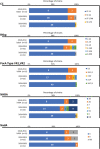Bactericidal killing of meningococcal W strains isolated in Argentina by the sera of adolescents and infants immunized with 4-component meningococcal serogroup B vaccine (4CMenB)
- PMID: 38111094
- PMCID: PMC10732599
- DOI: 10.1080/21645515.2023.2288389
Bactericidal killing of meningococcal W strains isolated in Argentina by the sera of adolescents and infants immunized with 4-component meningococcal serogroup B vaccine (4CMenB)
Abstract
Invasive meningococcal disease (IMD) is a life-threatening disease caused by meningococcal serogroups A, B, C, W, X, and Y, of which B and W are most common in Argentina. The 4-component meningococcal serogroup B (4CMenB) vaccine contains three purified recombinant protein antigens (Neisseria adhesin A [NadA], factor H binding protein [fHbp], and Neisserial Heparin Binding Antigen [NHBA]) and outer membrane vesicles (OMV), which is derived from the New Zealand epidemic strain and contains Porin A 1.4. These antigens are present and conserved in strains that belong to other serogroups. In this study, we show that 10/11 (91%) meningococcal serogroup W (MenW) strains selected to be representative of MenW isolates that caused IMD in Argentina during 2010-2011 were killed in bactericidal assays by the sera of adolescents and infants who had been immunized with the 4CMenB vaccine. We also show that MenW strains that caused IMD in Argentina during 2018-2021 were genetically similar to the earlier strains, indicating that the 4CMenB vaccine would likely still provide protection against current MenW strains. These data highlight the potential of 4CMenB vaccination to protect adolescents and infants against MenW strains that are endemic in Argentina.
Keywords: 4CMenB vaccine; Argentina; Meningococcal B; Meningococcal W; cross-protection; vaccination.
Conflict of interest statement
Alessia Biolchi, Sara Tomei, and Florencia Nocita are employed by GSK. Mariagrazia Pizza, and Gabriela Vidal were employed by GSK at the time of the study. Mariagrazia Pizza is Professor at Imperial College (London). Alessia Biolchi holds shares in GSK. Josefina Campos was employed by ANLIS Dr. Carlos G. Malbrán at the time of the study. She also received grants from the Pan American Health Organization, Wellcome Trust, and EMBL European Bionformatics Institute; payment/honoraria for lectures from the Wellcome Trust Sanger Institute; and support for attending meetings and/or travel from the Pan American Health Organization, the World Health Organization, and the European Society in Clinical Microbiology and Infectious Diseases. Carla Vizzotti is the current Minister of health in Argentina. These authors declare no other financial or non-financial relationships and activities. Adriana Efron, Cecilia Sorhouet Pereira, Denise De Belder, María Alicia Moscoloni, and Mauricio Santos declare no financial or non-financial relationships and activities and no conflicts of interest.
Figures
References
-
- Ministerio de Salud Argentina . Boletín epidemiológico nacional. Número 657. 2023. [accessed 2023 Aug 31]. https://bancos.salud.gob.ar/sites/default/files/2023-06/BEN%20657_SE23_2....
-
- Gabastou J-M, Agudelo CI, Brandileone MC, Realpe ME, de Oliveira L, de Lemos APS, Valera D, Informe Regional de Sireva II 2007 . Datos por país y por grupos de edad sobre las características de los aislamientos de Streptococcus pneumoniae, Haemophilus influenzae y Neisseria meningitidis, en procesos invasores. Washington (DC): Organización Panamericana de la Salud; 2008. [accessed 2023 Jun 2]. https://www.paho.org/es/node/32048.
Publication types
MeSH terms
Substances
LinkOut - more resources
Full Text Sources
Other Literature Sources
Medical


